A very slow metabolic rate allows Koalas to retain food within their digestive system for a relatively long period of time, maximising the amount of energy able to be extracted. At the same time, this slow metabolic rate minimises energy requirements. Koalas also sleep somewhere between 18 and 22 hours each day in order to conserve energy.
The Koalas’ digestive system is especially adapted to detoxify the poisonous chemicals in the leaves. The toxins are thought to be produced by the gum trees as a protection against leaf-eating animals like insects. Trees which grow on less fertile soils seem to have more toxins than those growing on good soils. This could be one reason why Koalas will eat only certain types of eucalypts, and why they will sometimes even avoid them when they are growing on certain soils.
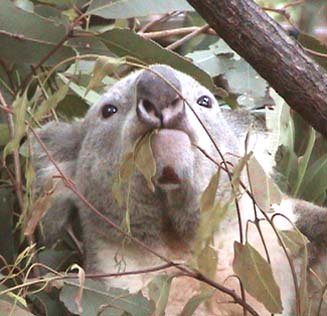
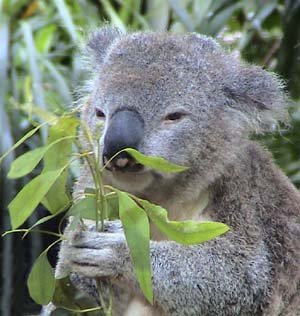
Photos by August, Hsueh-Cheng Ho
Koalas have a special fibre-digesting organ called a caecum. Other animals, such as humans also have a caecum, but the Koala’s is very long (200 cms). The caecum contains millions of bacteria which break down the fibre into substances which are easier to absorb. Even so, the Koala is still only able to absorb 25 per cent of fibre eaten. Water is also absorbed from the gumleaves, so that Koalas rarely need to drink, although they can do so if necessary, such as in times of drought when the water content of the leaves is reduced.
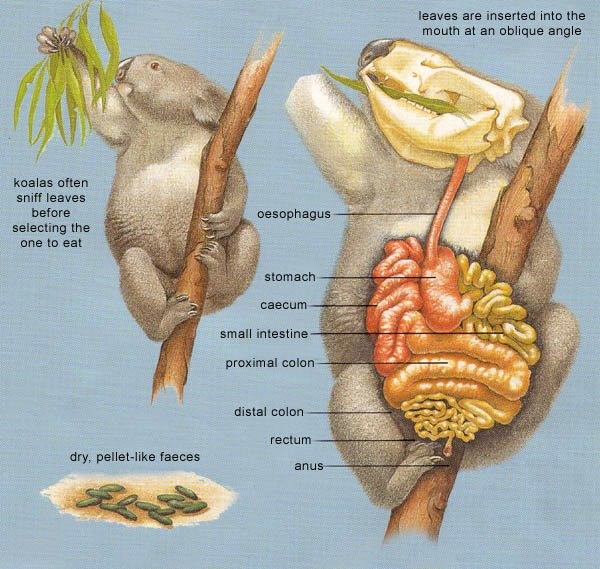
P.Schouten, From ‘Koalas, the little Australians we’d all hate to lose’ Bill Phillips AGPS
Each Koala eats approximately 200 to 500 grams of leaves per day. The teeth are adapted to deal with their specialised diet. The sharp front incisors nip the leaves from the tree. The molars, or back teeth are shaped to allow the Koala to cut and shear the leaves rather than just crush them. A gap between the incisors and the molars, called a ‘diastema’, allows the tongue to move the mass of leaves around the mouth efficiently.
Koalas are very fussy eaters and have strong preferences for different types of gum leaves. In Australia there are over 600 types of eucalypts, but Koalas will not eat a large proportion of these. Within a particular area, as few as one, and generally no more than two or three species of eucalypt will be regularly browsed. (we call these “primary browse trees”) while a variety of other species, including some non-eucalypts, appear to be browsed occasionally or used for just sitting or sleeping in.
Different species of eucalypts grow in different parts of Australia, so a Koala in Victoria would have a very different diet from one in Queensland. Also, just think how boring it would be to eat the same thing every day. Koalas like a change, too, and sometimes they will eat from other trees such as wattle, tea tree or paperbark.
Diet & Habitat
Find out more information about ‘ecosystems’. Find out what ‘ micro-organisms’ are. If you live in a koala area, find out what type of eucalyptus the koalas in your area like to eat.
Some people think that koalas sleep a lot because they get drunk on the eucalyptus oil in gum leaves. That’s not true!
Koalas sleep or rest for up to 22 hours each day because their bodies need a lot of energy to digest the gum leaves and when they are sleeping they save energy. Very few animals can survive on a diet of gum leaves. They are very fibrous and low in nutrition, and this is why they take a lot of energy to digest.
 As well, to almost all other animals they are poisonous. However, koalas are especially adapted to eat this diet.
As well, to almost all other animals they are poisonous. However, koalas are especially adapted to eat this diet.
They have a special part in their intestine, called a caecum (pronounced see-kum), which goes off from their main intestine and has a blind end. It is very long and broader than the rest of the intestine and contains millions of micro-organisms (tiny organisms) that break down the gumleaves so they are easier to absorb. There is water in the gumleaves, too, so that koalas rarely need to drink.
Koala teeth are especially adapted for their gumleaf diet. Their sharp front teeth nip the leaves from the tree and their back teeth are shaped for cutting and grinding the leaves to extract the most nourishment.
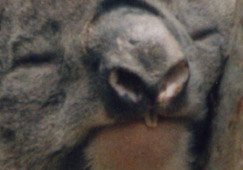 An adult koala eats between 200 to 500 grams of leaves each day. Koalas eat mainly eucalyptus leaves (gum leaves). Occasionally they will eat the leaves from some other native Australian trees, and they also use certain trees just for resting in.
An adult koala eats between 200 to 500 grams of leaves each day. Koalas eat mainly eucalyptus leaves (gum leaves). Occasionally they will eat the leaves from some other native Australian trees, and they also use certain trees just for resting in.
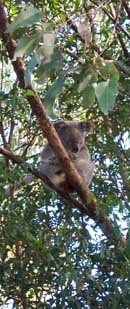 Koalas live in tall open eucalypt (gum tree) forests. The areas of bushland where they like to live are called their HABITATS. Koalas can only live in bushland where their favourite trees are growing, and they will only eat a few of the hundreds of species of eucalypts which grow in Australia.
Koalas live in tall open eucalypt (gum tree) forests. The areas of bushland where they like to live are called their HABITATS. Koalas can only live in bushland where their favourite trees are growing, and they will only eat a few of the hundreds of species of eucalypts which grow in Australia.
Just as people in different countries like the kinds of foods they are accustomed to eating, koalas in different areas of Australia like to eat the leaves from different types of gum trees. For instance, koalas in Victoria eat the leaves of different gum trees from those eaten by koalas in Queensland.
Like pasture for sheep, a forest can only support a limited number of koalas because the available gumleaves can only feed a certain number of koalas. If there are too few trees in an area of forest, for instance, if some of the forest has been cleared for housing or other development, the koalas may eat more leaves than the trees can regenerate (re-grow) and the trees may die. Then the koalas may get sick or die, too.
When the forest is in balance, this does not happen, but when the forest and the surrounding land has been damaged by clearing, logging or pollution, the animals which live in that forest will suffer, too. In most cases, we humans are responsible for damaging and changing many fragile ecosystems on earth, some of which support koalas.

